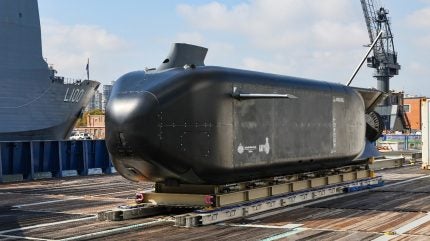
The Ghost Shark XL-AUV, an extra-large autonomous undersea vehicle developed by Anduril Industries, has arrived in the United States via a Royal Australian Air Force (RAAF) C-17A.
Anduril Australia unveiled the Ghost Shark as a new extra-large autonomous undersea vehicle (XL-AUV) developed for the Royal Australian Navy (RAN). This project, which began in May 2022, involves a A$140m ($93.8m) co-development agreement between Anduril, RAN, the Advanced Strategic Capabilities Accelerator (ASCA), and the Defence Science Technology Group. The aim is to produce three prototypes within three years.
The first prototype, revealed in April this year, was assembled by 121 engineers from 42 Australian companies.
The Ghost Shark’s US debut coincides with Exercise Rim of the Pacific (RIMPAC), held near the Hawaiian Islands. The Ghost Shark is a multi-role platform and a force multiplier for naval forces.
The collaboration between Anduril Industries and the Royal Australian Navy formalised in a 2022 co-development contract, has witnessed the early delivery of the first Ghost Shark prototype.
The Ghost Shark’s journey across the Pacific marks an expansion of its testing and operational capabilities. This bi-coastal approach will accelerate learning and iteration to refine the vehicle’s capabilities in real-world scenarios.
For the United States, the Ghost Shark’s arrival offers a unique opportunity to collaborate closely with Australia on developing a new generation of autonomous systems. It also highlights a broader trend in military strategy: the increasing reliance on unmanned systems in an era of evolving threats.
The Ghost Shark XL-AUV is a deterrent force in the undersea domain. Its presence in the US is a milestone and a signal of the future of naval warfare, where international collaboration will be key to maintaining security in the world’s oceans.
In August 2024, Anduril raised A$1.5bn in a Series F funding round, bringing its valuation to A$14bn. The funding, co-led by Founders Fund and Sands Capital with participation from new and existing investors, will be used to scale up operations. The company plans to develop Arsenal-1, a new facility expected to produce tens of thousands of autonomous systems annually.







